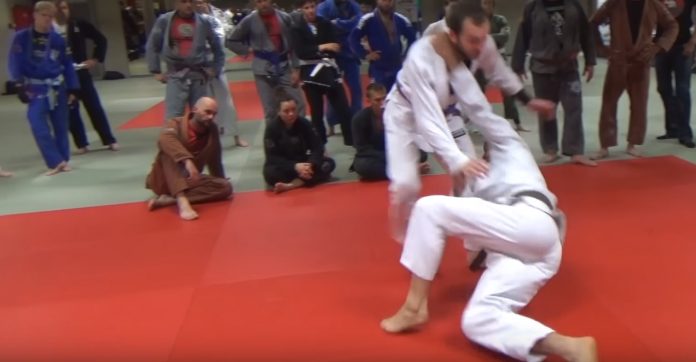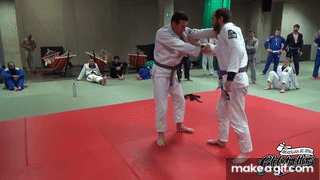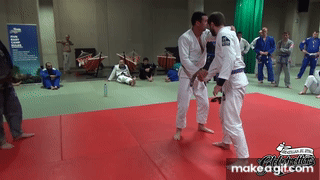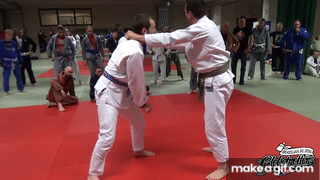
The subject of takedowns has been beaten to death, yet still, a lot of innovation emerges in that area of BJJ. As the art evolves we’re living witnesses to a huge and important shift in focus. From its inception, BJJ focused on “borrowing” takedown and throw techniques from other martial arts. As the art evolves, though, it seems like it’s slowly finding its own legs to stand on. Today, BJJ is done borrowing and is instead, looking to modify straightforward wrestling or Judo takedowns. These techniques are somewhat limited because they’re meant for Judo or Wrestling. And, since BJJ is known as the art where experimentation is encouraged, it’s not surprising that you’re seeing Judo staples modified to No-Gi grappling or vice versa. The Russian Tie Throw is one such example.
The distinct lack of original BJJ takedowns is somewhat of a conundrum. As a grappling martial art, Jiu-Jitsu thrives on the bottom. However, getting the match or fight there, seems to be second in importance to what happens on the ground. Which is somewhat confusing, to say the least. Luckily, the latest direction is one of innovation and combination, rather than imitating other arts. Today, we’re going to be exploring a very reliable wrestling technique and how to modify it to Gi BJJ. it is the Russian tie throw, which most people perceive as a distinctly wrestling/No-Gi move. Today, we’ll try to change that and demonstrate just how far BJJ can evolve.
While modifications are absolutely necessary, they do not mean the original move needs to be discarded. As Hudson Taylor demonstrates in his “Wrestling For BJJ” DVD set, Jiu-Jиtsu has a lot to more to learn and integrate from Wrestling. Check it out to improve your takedown and top position game quickly and massively!
The Wrestling Russian Tie Throw
The Russian tie throw is a very powerful technique that works just as good in BJJ as it does in wrestling. It is just one option from the Russian tie position that we covered in depth in another article. The Russian tie is a very versatile position that can lead to cradles, front headlocks, single leg takedowns, ankle picks and more. On top of it all, there’s also the Russian tie throw that’s as impressive as it is effective.

For a direct Russian tie throw, all you need to do is look to roll under your opponent, aiming to get your head in between his legs. This is going to take your opponent over your body and down to the other side. When done fast and explosive, this is a truly unstoppable takedown. The fact that it works just a well on a bent opponent and on one attempting to regain posture, it is the perfect fit for BJJ. And now you can do it with Gi grips as well.
The BJJ Russian Tie Throw With The Gi
The first thing to understand about the modified Russian tie throw for BJJ is that the dynamics of the setup are significantly different. This is due to the fact that the Gi grips make the positioning a lot different than in wrestling or No-Gi. Her, you’ll be standing in front of your opponent while you’re setting the throw up. Let’s take it to step by step.
Step 1: Establishing Grips

Step 2: Kuzushi And Movement
Since you’re now standing in front of your opponent, you’ll want to change your approach, or you’ll just roll under giving away side control. The thing to add here is one of the key Judo principles – Kuzushi. translated from Japanese, this means off balancing. To get your opponent out of balance, you’ll have to threaten their posture and base at the same time.

Step 3: The Roll
What an experienced opponent is going to do is retract the leg you’re attacking with the foot sweep. This is actually what you want. Now, you have the opponent standing in an Orthodox stance, the same as you. This opens up space you need to execute the Russian tie throw.

As you get your head in position, remember your grips. Tuck the elbow of the arm that grips the opponent’s sleeve very close to your torso. Use the collar grip to pull once your head touches the ground in front of the opponent’s foot. From there, simply extend your legs and roll like a log across your back, taking the opponent over you. You end up in a great position to take the back or hit an armbar. Just remember to keep a hold of both grips until the very end.


![Darce Choke Encyclopedia – Origins, Mechanics and Variations [2025] BJJ, choke, Brabo, BJJ Darce Choke, D'arce Choke, Darce BJJ Choke](https://bjj-world.com/wp-content/uploads/2017/11/JungPoirierLeeYahoo-218x150.jpg)









![Countering with Crab Ride Anthony Budion DVD Review [2025] Countering with Crab Ride Anthony Budion DVD Review](https://bjj-world.com/wp-content/uploads/2025/03/countering-with-crab-ride-anthony-budion-dvd-review-218x150.png)
![Closet Closed Guard Craig Jones DVD Review [2025] Closet Closed Guard Craig Jones DVD Review](https://bjj-world.com/wp-content/uploads/2025/03/closet-closed-guard-craig-jones-dvd-review-218x150.png)
![Xanadu Back Takes Levi Jones-Leary DVD Review [2025] Xanadu Back Takes Levi Jones-Leary DVD Review](https://bjj-world.com/wp-content/uploads/2025/03/xanadu-back-takes-levi-jones-leary-dvd-review-218x150.png)

![No-Gi Grapplers Guide To Front Headlock Joel Bane DVD Review [2025] No-Gi Grapplers Guide To Front Headlock Joel Bane DVD Review](https://bjj-world.com/wp-content/uploads/2025/03/no-gi-front-headlock-joel-bane-dvd-review-218x150.png)

![Unpinnable Mount Escape Mastery Haleem Syed DVD Review [2025] Mount Escape Mastery Haleem Syed DVD Review](https://bjj-world.com/wp-content/uploads/2025/01/mount-escape-mastery-haleem-syed-dvd-review-100x70.png)



![Forging The De La Riva Guard Giancarlo Bodoni DVD Review [2025]](https://bjj-world.com/wp-content/uploads/2025/02/de-la-riva-guard-giancarlo-bodoni-dvd-review-100x70.png)


![Collar Sleeve Guard Mikey Musumeci DVD Review [2024] Collar Sleeve Guard Mikey Musumeci DVD Review](https://bjj-world.com/wp-content/uploads/2024/12/collar-sleeve-guard-mikey-musumeci-dvd-review-100x70.png)


![Tricks for Unstoppable Takedowns Georges St Pierre DVD Review [2024] Tricks for Unstoppable Takedowns Georges St Pierre DVD Review](https://bjj-world.com/wp-content/uploads/2024/12/unstoppable-takedowns-georges-st-pierre-dvd-review-100x70.png)

![Heavy Top Game Fabiano Scherner BJJ DVD Review [2025] Heavy Top Game Fabiano Scherner BJJ DVD Review](https://bjj-world.com/wp-content/uploads/2025/01/heavy-top-game-fabiano-scherner-bjj-dvd-review-100x70.png)
![Trip Throw Dilemma Michael Pixley and Heath Pedigo DVD Review [2024] Trip Throw Dilemma Michael Pixley and Heath Pedigo DVD Review](https://bjj-world.com/wp-content/uploads/2024/10/trip-throw-dilemma-michael-pixley-dvd-review-100x70.png)
![Jeff Glover DVD Bundle Review: Chokin’ Around With Uncle Jeff [2024] Jeff Glover DVD Bundle Review: Chokin' Around With Uncle Jeff](https://bjj-world.com/wp-content/uploads/2024/10/jeff-glover-dvd-bundle-review-chokin-around-100x70.png)
![Mastering The Crucifix Alexandre Pereira DVD Review [2025] Mastering The Crucifix Alexandre Pereira DVD Review](https://bjj-world.com/wp-content/uploads/2025/01/mastering-the-crucifix-alexandre-pereira-dvd-review-100x70.png)
![Simplify the System Side Scissor Brian Glick DVD Review [2024] Simplify the System Side Scissor Brian Glick DVD Review](https://bjj-world.com/wp-content/uploads/2024/09/side-scissor-brian-glick-dvd-review-2024-100x70.png)


![Dubious De La Riva Dominique Bell DVD Review [2024] Dubious De La Riva Dominique Bell DVD Review](https://bjj-world.com/wp-content/uploads/2024/10/dubious-de-la-riva-dominique-bell-dvd-review-100x70.png)
![Dima Murovanni Kill The Collar Tie BJJ Trendsetters DVD Review [2024] Dima Murovanni Kill The Collar Tie BJJ Trendsetters DVD Review](https://bjj-world.com/wp-content/uploads/2024/09/dima-murovanni-kill-the-collar-tie-dvd-review-100x70.png)




![Complete Fundamentals Curriculum Eliot Marshall DVD Review [2025] Complete Fundamentals Curriculum Eliot Marshall DVD Review](https://bjj-world.com/wp-content/uploads/2025/02/fundamentals-curriculum-eliot-marshall-dvd-review-100x70.png)
![Baseball Chokes From Everywhere Magid Hage DVD Review [2025] Baseball Chokes From Everywhere Magid Hage DVD Review](https://bjj-world.com/wp-content/uploads/2025/01/baseball-chokes-from-everywhere-magid-hage-dvd-review-100x70.png)
![Intro To Hip Mobility for Guard Players Joshua Presley DVD Review [2024] Intro To Hip Mobility for Guard Players Joshua Presley DVD Review](https://bjj-world.com/wp-content/uploads/2024/09/hip-mobility-for-guard-joshua-presley-dvd-review-100x70.png)